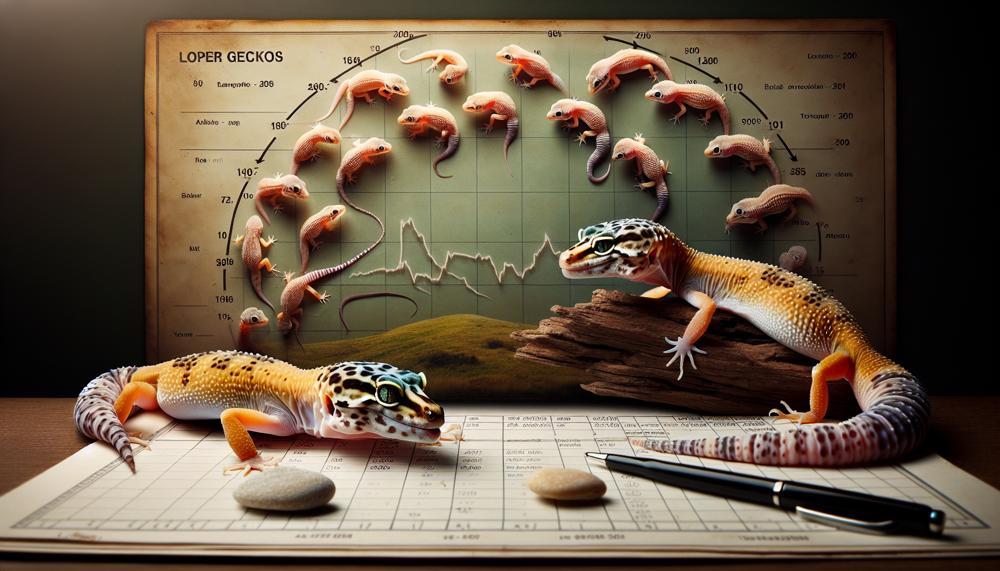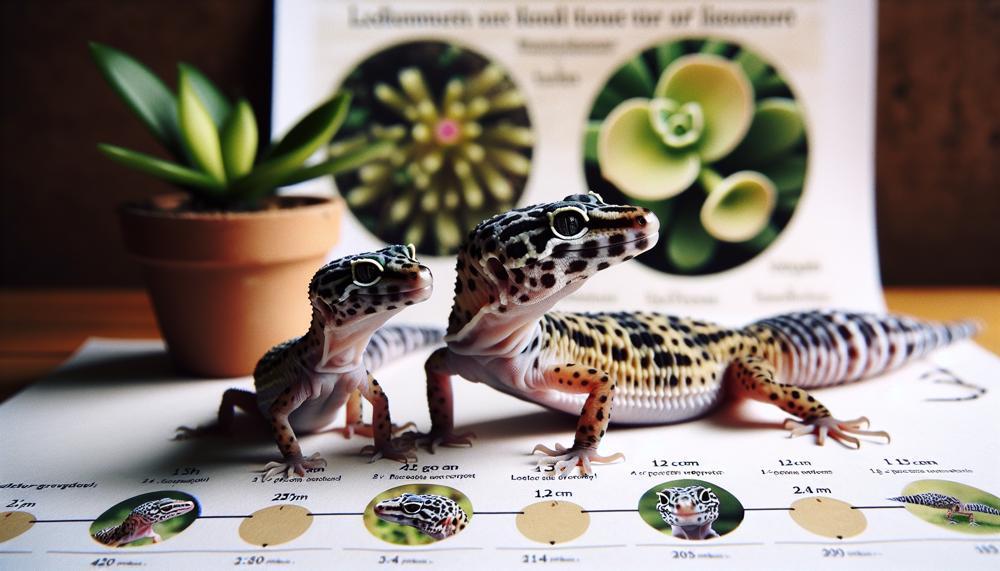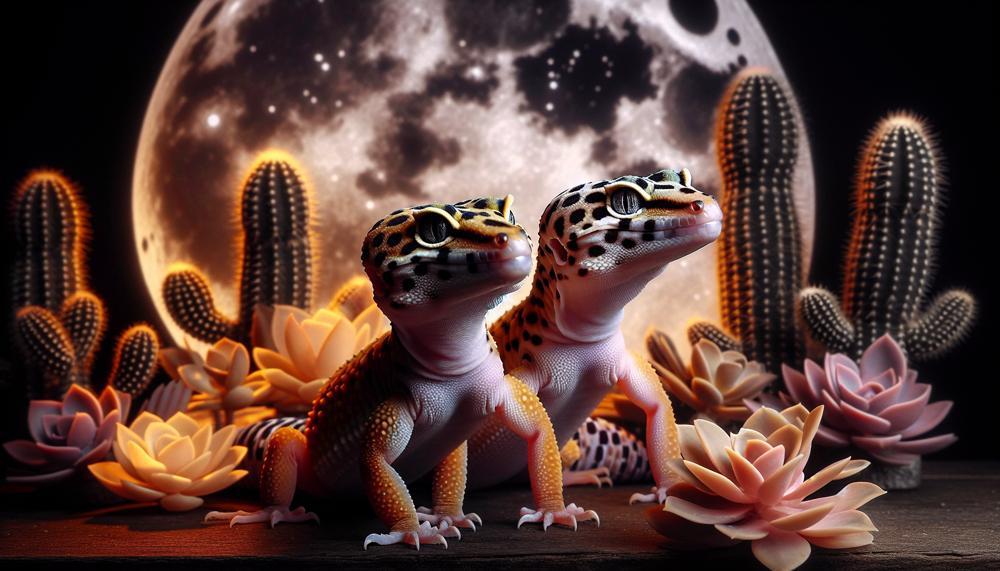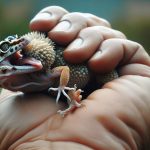Do you have a soft spot for reptiles? If so, get ready to embark on an exciting journey into the world of leopard geckos. These captivating creatures have stolen the hearts of many with their stunning appearance and gentle demeanor. But what exactly is their lifespan like? Today, we’ll be delving into this topic and uncovering some fascinating facts about these little wonders.
First things first, let’s talk numbers. In captivity, leopard geckos can live up to 20 years. That’s two decades of companionship with these charming creatures. However, in the wild, their lifespan is typically shorter due to natural predators and environmental factors. But don’t worry, with proper care and nutrition, you can help your leopard gecko live a long and healthy life.
As they age, leopard geckos may undergo changes in behavior and appearance. Just like humans, they may become less active or develop gray patches on their skin. But fear not, with regular check-ups from a trusted veterinarian and a balanced diet, these changes can be managed effectively.
With advances in veterinary care, there are now ways to extend the lifespan of these beloved pets. So if you’re considering adding a leopard gecko to your family or already have one as a companion, this blog post will provide valuable insights on how to give them the best life possible.
So, grab your favorite book on reptiles and let’s dive into the fascinating world of leopard geckos.
Contents
The Lifespan Of A Gecko
When it comes to the lifespan of a gecko, there are a few things you need to keep in mind. The average lifespan of a leopard gecko ranges from 10 to 15 years, but some individuals can live up to 20 years.
However, there are certain factors that can influence their longevity, such as their diet, living environment, genetics, stress levels, and overall care and hygiene. To ensure your leopard gecko lives a long and fulfilling life, it is essential to provide a well-rounded diet, proper housing, and regular veterinary check-ups.
Diet plays a crucial role in the health and lifespan of a leopard gecko. It is essential to offer a variety of insects such as crickets, mealworms, and waxworms, along with calcium and vitamin D3 supplements.
A diverse diet ensures that your gecko receives all the necessary nutrients for optimal health. However, it is important to avoid feeding them citrus fruits or any fruit with seeds or pits, as these can be toxic to reptiles.
Proper housing is also crucial for the wellbeing of your leopard gecko. They require a warm and humid environment with hiding spots and a shallow water bowl for soaking. The right temperature and humidity levels are important for digestion and shedding. A stressed or dehydrated gecko is more prone to health issues and has a shorter lifespan.
Genetics also play a role in the lifespan of leopard geckos. Some may be genetically predisposed to certain diseases or conditions that can affect their longevity.
Regular vet check-ups can help catch any potential health issues early on and ensure proper treatment.
In The Wild vs In Captivity
Leopard geckos are fascinating creatures with an average lifespan of 6 to 8 years in the wild and 10 to 20 years in captivity. This significant difference is attributed to various factors that greatly affect their health and well-being.
In The Wild:
Leopard geckos living in the wild have a shorter lifespan due to harsh environmental conditions and predators lurking around every corner. These brave little creatures face extreme temperatures, scarcity of food and water, and potential predators, all of which contribute to a shorter lifespan.
Moreover, wild leopard geckos do not receive regular veterinary care or proper nutrition, which can lead to various health issues and ultimately impact their longevity.
In Captivity:
On the other hand, leopard geckos kept as pets enjoy a longer lifespan due to the love and care provided by their owners. In captivity, these reptiles are given a suitable living environment with regulated temperatures, a diverse diet, and regular access to food and water.
Additionally, pet leopard geckos have access to veterinary care if needed, which can greatly improve their overall health and lifespan.
Factors That Affect Leopard Gecko Lifespan:
Aside from living conditions, several other factors can influence the lifespan of leopard geckos. These include genetics, diet, and overall health.
Proper care and a suitable environment can help maximize the lifespan of these creatures, whether they are in the wild or in captivity.
| In The Wild | In Captivity | |
| Average Lifespan | Shorter (6-8 years) | Longer (10-20 years) |
| Living Conditions | Harsh environmental conditions, scarcity of food and water, potential predators | Regulated temperatures, diverse diet, regular access to food and water |
| Veterinary Care | Not Available | Available if needed |
| Impact on Lifespan | Shortened due to environmental factors and lack of proper care | Extended due to suitable living conditions and access to proper care |
Does Gender Matter?
The biological makeup of leopard geckos greatly impacts their lifespan, with a notable difference between males and females. While male leopard geckos can live up to 10-20 years, females typically have shorter lifespans of 6-10 years.
This is due to the physical differences between the two genders, particularly in terms of reproductive capabilities.
| Gender | Average Lifespan | Factors Affecting Lifespan |
| Male | 10-20 years | No reproductive stress, lower energy expenditure |
| Female | 6-10 years | Reproductive stress, energy expenditure from egg production, potential breeding complications |
Female leopard geckos experience additional stress and use more energy during egg production, which can have a negative impact on their overall health and lifespan. Furthermore, breeding can pose potential risks and complications for female leopard geckos, further shortening their lifespan.
On the other hand, male leopard geckos do not undergo such physical stresses and are able to live longer lives. With no reproductive obligations, they can live up to 10-20 years on average.
It is worth noting that various factors such as environment and proper care also play a significant role in the lifespan of leopard geckos. In the wild, harsh living conditions, lack of care, and predators can greatly reduce their lifespan.
However, providing them with suitable living conditions and proper care in captivity can greatly extend their lifespan.
These Geckos Beat The Odds

Leopard geckos are known for their resilience, thanks to their unique physical characteristics, specific behaviors, and adaptations that allow them to thrive in harsh desert environments.
These traits also make them captivating pets to observe and care for.
Physical Features:
| Mottled Skin Patterns | One of the most distinctive features of leopard geckos is their mottled skin patterns, which serve as camouflage and help them blend into their surroundings. This makes it challenging for predators to spot and catch them in the wild. | “Leopard geckos have a one-of-a-kind skin pattern that enables them to become one with their environment, making it harder for predators to prey on them.” |
| Large Eyes | Their large, expressive eyes serve not only an aesthetic purpose but also a functional one. With these eyes, leopard geckos can have a wide field of view and detect potential threats more easily. | “The large eyes of leopard geckos are not just for show – they also play a significant role in helping them spot predators and avoid danger.” |
Behaviors:
| Hunting Behaviors | Leopard geckos have evolved specific hunting behaviors, such as stalking and pouncing on their prey, which are crucial for their survival in the harsh desert environment where they live. | “To survive in their unforgiving desert habitat, leopard geckos have developed effective hunting behaviors, such as stealthily stalking and pouncing on their prey.” |
| Mating Behaviors | Their unique mating behaviors, including territorial displays and courtship rituals, offer insights into their evolutionary history and contribute to their resilience as a species. | “Leopard geckos have fascinating mating behaviors that provide us with valuable information about their evolution and contribute to their resilience as a species.” |
Adaptations:
| Ability to Survive in Harsh Environments | Leopard geckos have adapted to thrive in the harsh desert environment they call home. Their features, such as moisture-retaining scales and specialized kidneys, allow them to retain water and survive in the arid conditions. | “Thanks to their adaptations, such as moisture-retaining scales and specialized kidneys, leopard geckos are able to thrive in their harsh desert habitat.” |
Gecko Life Stages
Leopard geckos go through three unique life stages: hatchling, juvenile, and adult. These stages each have their own set of characteristics and needs, and they usually last for varying amounts of time.
Hatchling Stage:
- The hatchling stage is the first phase of a leopard gecko’s life, starting from the moment they are born.
- During this stage, hatchlings are usually around 3-4 inches long and are approximately 2 months old.
- They display a pattern of stripes or bands on their body that will eventually fade as they grow older.
- Due to their fragility, hatchlings require extra care and attention to ensure their survival.
- This stage generally lasts for 2-3 months.
Juvenile Stage:
- The juvenile stage can be likened to the teenage years for leopard geckos.
- It begins when the gecko reaches about 3-4 months old and continues until they reach sexual maturity at 12-18 months old.
- During this stage, leopard geckos continue to grow in size and coloration.
- They also start exhibiting adult behaviors such as territoriality and hunting instincts.
- Typically, the juvenile stage lasts for 9-12 months.
Adult Stage:
- The adult stage commences when the leopard gecko reaches sexual maturity at around 12-18 months old.
- At this point, they have reached their full size, which can range from 7-10 inches in length.
- Their patterns and colors are fully developed but may change slightly throughout their lifespan.
- Compared to younger geckos, adult leopard geckos are generally more docile and easy to handle.
- The adult stage can last anywhere from 15-20 years or even longer with proper care.
| Life Stage | Age Range | Unique Characteristics |
| Hatchling | 0-3 months | 3-4 inches in length, striped/banded pattern, fragile |
| Juvenile | 3-18 months | Growing and developing, displays adult behaviors, 7-10 inches in length |
| Adult | 12 months and above | Sexual maturity, full size and coloration, docile |
In conclusion, leopard geckos have three distinct life stages: hatchling, juvenile, and adult. Each stage has its own unique characteristics and requirements, and they typically last for varying amounts of time.
The hatchling stage lasts for 2-3 months, the juvenile stage lasts for 9-12 months, and the adult stage can last anywhere from 15-20 years or even longer with proper care.
Can Size Determine Age?

The size of a leopard gecko does not have a direct correlation with its lifespan. Although larger geckos may potentially live longer due to their size and ability to withstand health issues, the overall care and environment provided ultimately play a crucial role. Factors such as diet, housing, temperature, and humidity levels have a more significant impact on the gecko’s lifespan rather than its size.
However, it is worth noting that the size of a leopard gecko can serve as an indicator of its age. As they progress through different life stages, their size will correspondingly increase. Generally, larger and older geckos may have a longer lifespan due to their experience and resilience, but this is not always true.
To ensure that a leopard gecko lives a healthy and long life, it is essential to provide proper care from the very beginning. This includes creating an appropriate habitat, providing a well-balanced diet, and regularly monitoring their health. With proper care, leopard geckos can live for over 15 years in captivity.
| Life Stage | Size Range | Average Lifespan |
| Hatchling | 3-4 inches in length | 1-2 years |
| Juvenile | 5-6 inches in length | 3-5 years |
| Adult | 7-10 inches in length | 10+ years |
As shown in the table above, hatchlings and juveniles are smaller in size and have shorter lifespans due to their vulnerability and fragility.
However, with proper care, they can reach adulthood and potentially live for over 10 years.
Much Is Still Uncertain
The lifespan of a leopard gecko is not set in stone and can vary greatly from one gecko to another. Some may live up to 28 years in captivity, while others may only survive a few years. This uncertainty is due to several factors, including genetics, environment, diet, and health.
While there are no guarantees for a specific lifespan, owners can take certain actions to give their geckos the best possible chance at a long and healthy life.
Genetics:
Like all living creatures, leopard geckos inherit traits from their parents that can affect their lifespan.
Some geckos may have genetic predispositions to certain health issues, while others may have stronger immune systems and overall better health.
Unfortunately, this factor is out of the owner’s control.
Environment:
The environment in which a leopard gecko lives plays a significant role in its lifespan.
In captivity, owners must provide adequate space, temperature, and humidity levels for their geckos to thrive. Improper conditions can lead to stress and illness, ultimately shortening their lifespan.
Owners should also make sure to provide hiding places and proper substrate for their geckos to feel safe and secure.
Diet:
A well-rounded and balanced diet is crucial for the longevity of leopard geckos.
Their diet should consist of live insects such as crickets and mealworms, as well as vitamin and calcium supplements. Improper nutrition can lead to health issues such as metabolic bone disease, which can significantly impact their lifespan.
Health:
Stressors such as parasites or other illnesses can also impact the lifespan of leopard geckos.
Owners should regularly monitor their geckos for any signs of illness or distress and seek prompt veterinary care when needed. A healthy gecko is more likely to have a longer lifespan.
Conclusion
In conclusion, the lifespan of leopard geckos can reach up to 20 years in captivity, making them long-term companions for those who choose to welcome them into their homes.
Their striking physical features, intriguing behaviors, and remarkable adaptations make them a captivating species to observe and care for. However, it is crucial to provide these creatures with proper nutrition, suitable housing, and regular veterinary care in order to ensure a healthy and fulfilling life.
While their lifespan may be shorter in the wild due to various environmental factors and predators, creating a safe and nurturing environment can greatly extend their time on this earth.
Moreover, it is important to note that gender also plays a significant role in the lifespan of leopard geckos, with females typically living shorter lives due to reproductive stress.






